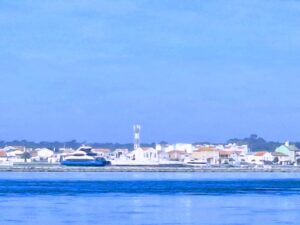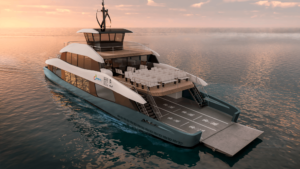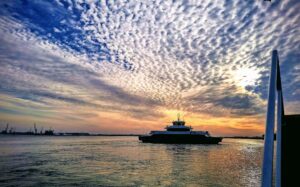Portugal’s First Electric Car Ferry Launched in Aveiro
The first fully electric car ferry in Portugal now connects the city of Aveiro with São Jacinto, home to Aveiro’s award-winning house beach on the Atlantic Ocean and gateway to the Dunas Nature Reserve, one of the top destinations for birdwatchers on the Iberian Peninsula.
.
São Jacinto sits across the Aveiro lagoon (Ria de Aveiro) on the tip of a peninsula that separates the Atlantic Ocean from the Ria and its marshlands. The new zero-emission ferry, named “Salicórnia”, now enables residents and visitors to set over to and from São Jacinto within minutes from downtown Aveiro via the Forte da Barra ferry terminal while reducing their carbon footprint.
.
The new electric vessel can transport 260 passengers and 19 motor vehicles. This means a substantial increase in capacity compared to the old ferry, which was propelled by fossil fuel (diesel). The change to electric power is expected to eliminate about 300 tons of carbon dioxide emissions from the atmosphere annually.
.
Low noise levels and a 360º panoramic view from the top deck allow passengers to enjoy a quiet ride and unique sights of the Ria and São Jacinto, a former fishing village. Salicórnia was designed and built entirely in Portugal. The launch of an electric ferry “made in Portugal” significantly advances the country’s zero-emission maritime transport infrastructure, emphasizing sustainability and innovation.
.
The electrical ferry was planned with more than cars in mind: come spring and summer, it will be packed with bicyclists from Portugal and all around the globe, if past seasons on the old ferry are any indication. São Jacinto is a favorite pit stop for bikers on the Grande Rota da Ria de Aveiro, the region’s 350+ miles network of bike paths. EuroVelo, a long distance biking route that connects European countries along the Baltic and Atlantic coasts, also runs through São Jacinto.
.
The new ferry strengthens the position of Aveiro, which is the Portuguese Capital of Culture 2024, as one of the most unique destinations for sustainable tourism in Europe. Local community leaders, environmentalists, and proponents of sustainable tourism have hailed Salicórnia as a pioneering project on the Iberian Peninsula.
.
The vessel was built by the Portuguese ETE Group, owner of the Navaltagus shipyard. It was financed by Aveiro and co-financed by various entities, including POSEUR, Portugal 2020, and the European Union through the Cohesion Fund.
.
To ensure a smooth transition, the old car ferry Cale de Aveiro will serve as a backup transport during the first months of the new boat’s operation. Aveiro’s modernization of its São Jacinto ferry connection represents an investment of more than €9 million, including the charging stations.
.
The vessel’s name, Salicórnia, was chosen for its symbolic value. It speaks to the sense of place, grit, and ingenuity that the Aveirenses (Portuguese for “people of the Aveiro region”) have historically shown in the face of adversity.
.
What’s in a – ferry’s – name? Aveiro named its innovative vessel after a plant species, the “Salicórnia Perennis” (glasswort). Salicórnia is a halophyte that thrives in saline environments such as salt marshes. The plant plays a crucial ecological role in the Aveiro lagoon with its extensive salt marshes, contributing to the area’s overall environmental diversity and balance.
.
Like the people of Aveiro, which traces its roots back more than 3,000 years to Phoenician seafarers, the plant is known for its resilience and adaptability.

Quiet ride: Salicórnia connects the “mainland” with São Jacinto, Aveiro’s beach community on the other side of the lagoon. Image: Alex Alves for Casa dos Jacintos

Salicórnia: “Made in Portugal” for comfortable commutes and sustainable transport and tourism on the Aveiro lagoon. Source: NAVALTAGUS (Press Photo)

Silent ride at sunset: Aveiro’s new ferry on its way from Forte de Barra to São Jacinto. Photo: Alex Alves for Casa dos Jacintos